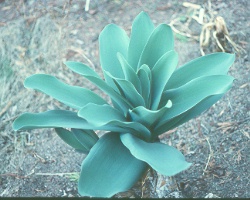
Brunsvigia josephinae
Here, several months have passed. The flowers that were fertilized have
set the peculiar Amaryllid seed, and the whole inflorescence, at least in
the wild, would have broken off and gone rolling across the veld
to spread the seed far and wide. In this suburban California garden,
I suspect the stalk succumbed to the gardener's shears. Which occasions
an aside: it is wise to be careful when pruning the Amaryllids. It is
becoming increasingly obvious that they are quite susceptible to viral
infections after the fashion of orchids (after all, these plants are
all petaloid monocots: ambitious grasses with showy flowers.) In many
cases these infections do not seem to damage the flowers, but they can
definitely ruin the leaves with unsightly blotching and discoloration.
I have seen this quite often on commercially propagated Amaryllis
belladona. This is the more important when you consider that
the plant above is not a creature of few winters: it is likely that a
flowering size bulb of this species is probably over 7 years old.
This photo was taken around November. The young leaves will expand as
winter rainfall begins, and reach the dimensions of a small Agave
attenuata, for which the bulb in winter could easily be mistaken at
a distance.
NEXT SLIDE.................
PREVIOUS SLIDE
ABORT-return to menu
